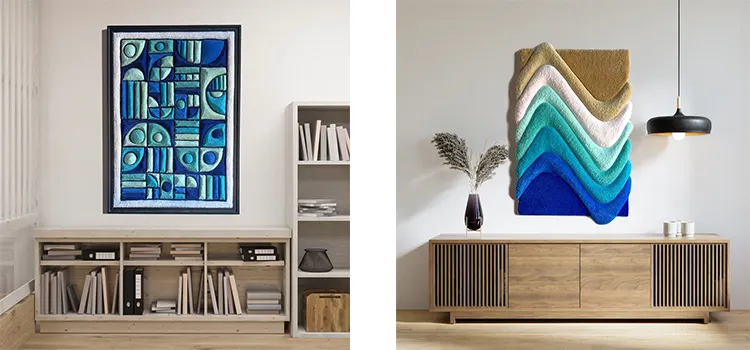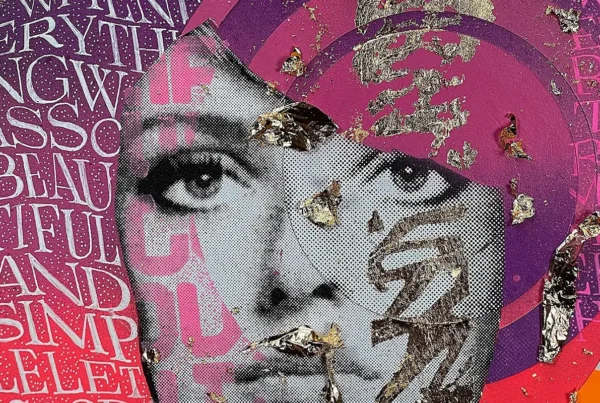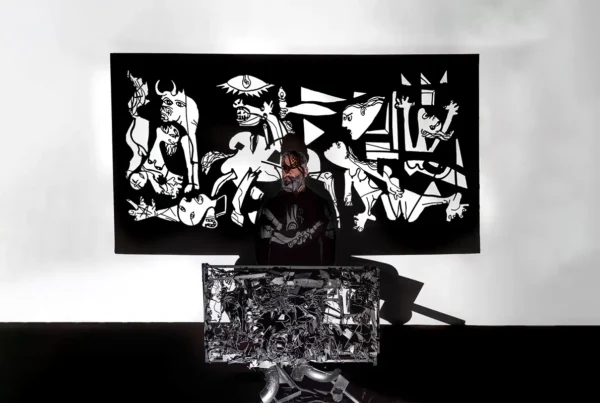The Evolution of Precision: From Dotwork to Tufting
David Nott’s artistic journey is a testament to his deep appreciation for precision and detail. Initially drawn to monochrome dotwork, he immersed himself in a meticulous practice that required thousands of carefully placed dots to construct intricate images. The meditative nature of this process honed his patience and technical control, reinforcing his fascination with methodical craftsmanship. However, as his artistic ambitions expanded, so did his desire to explore beyond the constraints of black and white. This curiosity led him to textiles, where he found a new medium that allowed him to experiment with both texture and color while maintaining the same level of precision that initially captivated him.
Tufting became the next logical step in his evolution as an artist. Transitioning from ink to thread, he discovered a tactile and dynamic way to bring his designs to life. The shift wasn’t merely aesthetic—it was an expansion of his creative language. Where dotwork required meticulous layering of ink on paper, tufting offered a three-dimensional aspect that allowed him to sculpt forms with depth and movement. Each loop of yarn became an extension of his earlier techniques, transforming his monochrome compositions into vibrant, textural pieces.
For Nott, tufting wasn’t just about making rugs—it was an opportunity to redefine textile art. By pushing beyond traditional applications, he began experimenting with sculptural tufting, elevating the craft into something that interacted with space, light, and shadow. Instead of adhering to the conventional flatness of textile work, he played with layering and dimension, creating pieces that felt almost alive. This approach challenged expectations, inviting viewers to engage with his art in a more immersive and tactile way.
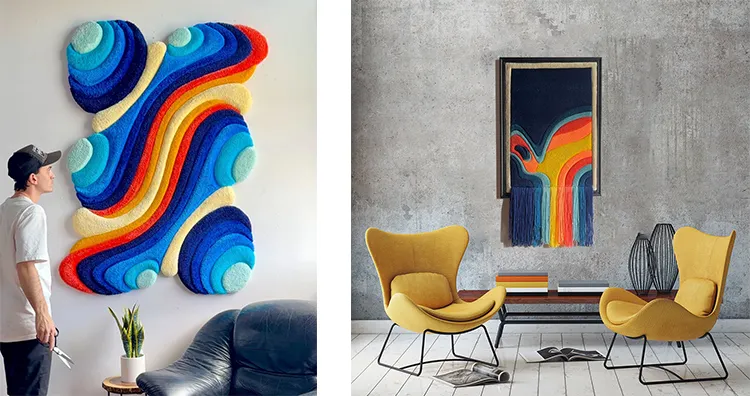
David Nott: Sculpting with Yarn and Color
Every piece Nott creates is the result of a meticulous and highly technical process. He begins by designing his compositions digitally, using Adobe Illustrator to map out patterns, shapes, and color palettes. This digital blueprint serves as the foundation for his work, ensuring that each element is carefully planned before transitioning to physical materials. Once satisfied with the design, he transfers the composition onto a large mesh canvas, where he manually executes the tufting process using a tufting gun.
Despite its mechanical-sounding name, tufting is an intricate craft that requires both technical precision and an intuitive understanding of texture. Each loop of yarn is strategically placed, and while Nott follows his digital roadmap, he allows for an organic flow, adjusting as needed to enhance depth and composition. The tufting phase alone can take dozens of hours, but the true transformation occurs during the sculpting process. With a combination of scissors and electric razors, he meticulously refines the piece, shaping the yarn into crisp edges, smooth gradients, and dynamic transitions. This sculpting stage is where his background in precision truly shines, as he carves and manipulates the fibers to achieve a striking level of detail.
The scale and complexity of his works demand an extraordinary commitment of time and resources. Some of his larger pieces require over 100 hours of labor and more than 35,000 yards of yarn. Yet, rather than viewing this intensity as a challenge, Nott embraces it as an essential aspect of his artistry. His dedication to craftsmanship ensures that each piece is not only visually compelling but also a testament to the time-honored principles of fine artistry in a contemporary context.
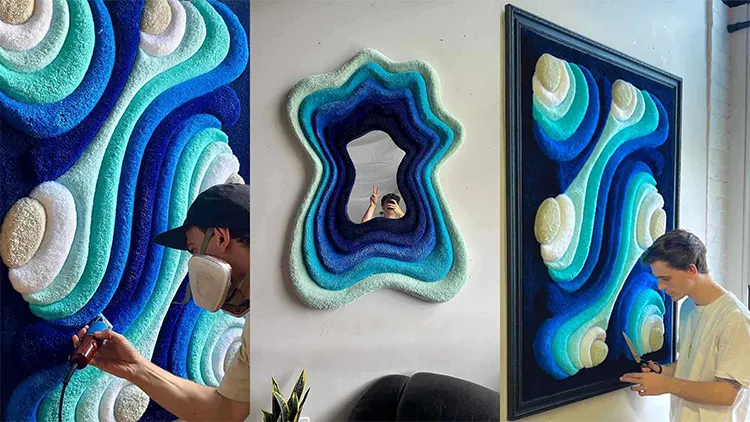
Breaking the Grid: The Language of Abstraction
Color and form are at the core of Nott’s artistic philosophy. Even during his monochrome dotwork phase, he was deeply invested in the study of contrast, depth, and perception. When he transitioned into full-color compositions, he approached the medium with the same analytical precision, carefully considering how colors interact and influence one another. His work is a deliberate exploration of balance—how bold contrasts and subtle gradients can coexist to create harmony within an abstract space.
His Journey Collection exemplifies this exploration, featuring pieces that challenge traditional boundaries through the interplay of color, shape, and movement. Works such as Portal, Dopamine, Flow, Spill, Balance, Colour Riddle, and Waves are more than just titles; they encapsulate the essence of their respective compositions. Portal, for instance, integrates a mirror within the tufted design, creating the illusion of an opening into another dimension. Dopamine harnesses vivid hues to evoke a sense of joy and energy, while Flow disrupts the notion of a rigid frame, allowing its organic lines to extend beyond the structured edges.
Each title reflects a conceptual narrative, inviting the viewer to interpret the piece beyond its visual form. In Spill, Nott plays with the illusion of material overflow, making the fabric appear as if it is escaping from the confines of its frame. Balance juxtaposes symmetry and asymmetry, highlighting the tension between control and spontaneity. Colour Riddle encourages a playful engagement with geometric puzzles, leading the viewer’s eye across interconnected shapes. Waves, on the other hand, captures the rhythmic motion of water through carefully arranged undulating forms. These works are not just studies in abstraction; they are visual dialogues that invite curiosity and contemplation.
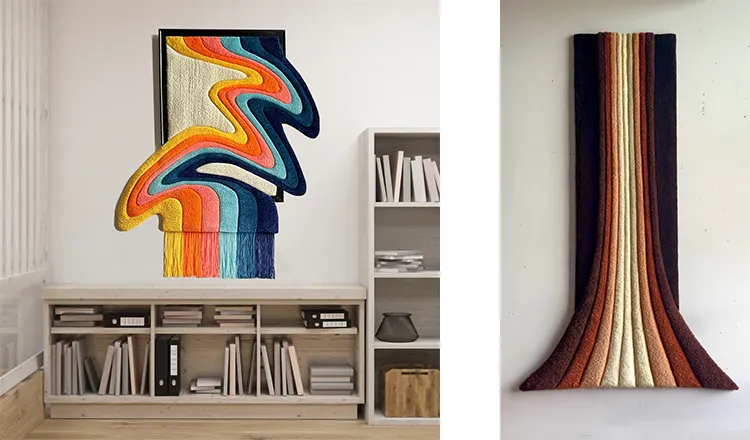
David Nott: Innovation, Collaboration, and the Future of Textile Art
Nott’s ability to redefine tufting has not gone unnoticed. His work has garnered attention from major brands and celebrities, leading to high-profile collaborations that push the boundaries of textile art. One standout partnership was with The North Face, where he transformed their iconic puffer coat into a tufted textile sculpture. This project challenged him to maintain the recognizable identity of the jacket while reinterpreting it through his unique medium. The result was a striking fusion of fashion and fine art, demonstrating the versatility of tufting beyond its conventional associations.
His growing recognition has also led to commissions from various celebrities, each piece tailored to reflect the personality and aesthetic preferences of its recipient. These collaborations not only broaden his artistic reach but also provide opportunities to experiment with new ideas and materials. Nott thrives on these challenges, as they push him to continuously evolve and refine his practice. His engagement with social media has played a pivotal role in expanding his audience, allowing collectors and art enthusiasts to witness his creative process in real-time. Platforms like Instagram and TikTok have transformed his art into an interactive experience, where followers can appreciate the labor-intensive journey behind each piece.
Looking ahead, Nott envisions an even more immersive approach to his work. His goal is to scale up his sculptural tufting into large-scale installations that invite physical engagement. He aspires to create environments where people don’t just observe his art but experience it as a multi-sensory phenomenon. Whether through interactive elements or architectural integrations, he aims to challenge how textile art is perceived and experienced. His relentless pursuit of innovation ensures that his work will continue to evolve, leaving an indelible mark on the contemporary art landscape.
